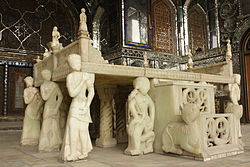Genie
Genies or jinns or djinns are supposed to be creatures resembling humans, but are invisible. Like humans, they would live in tribes, eat, drink and have emotions. But they are usually believed to be stronger than humans. While some people fear Jinn, others pray to them for protection. They are originally found in ancient myths and legends of the Middle East, especially Arabia. In Islam, it is forbidden to pray to them, and according to Islam, they have no true power, because they are, like humans, only created beings.
Nowadays, people in many Muslim countries like Saudi Arabia, Kuwait, Qatar, Palestine, Egypt, Iraq, Syria,United Arab Emirates, Libya, Algeria, Tunisia, Turkey, Iran, parts of Central Asia, Afghanistan and Pakistan believe in these Jinns or Djinns. Jinn are also common in legends and stories from the Middle East, for example in the One Thousand and One Nights.
Pre-Islamic Arabia
Before Islam, Jinn have been feared or venerated by people. Some prayed to them, so they would protect the caravans. Others feared the Jinn might cause sickness and storms. Especially when Jinn battle each other, storms would be caused. Jinn could become visible and invisible and turn into snakes. But despite their agile nature, they were similar to humans and a human could even be able to kill a Jinni in fight.
Islam
The holy book of Muslims, the Quran, mentions Jinns, and says that they are made from fire or smoke.[1] Like human beings, the jinn can be good or bad. The Quran did not introduce the Jinn, rather, the Quran accepts their existence, and tells how to deal with them. For example, the Quran rejects that Jinn are divine. The Jinn could not truly help humans, because they too will die. Like humans, they are only creatures made by God, and not gods themselves.
Many Muslims believe that Jinn have lived on earth long before humans. Some even think that humans were made to replace them . The Jinn would have been the first who lived on earth, but God was unsatisfied with them, so God decided to create a new creature (humans). Before creating humans, God would have sent an army of angels to kill most Jinn. Some Jinn survived, and sometimes people might meet them. Jinn, however, can turn invisible and suddenly disappear or shift their shape for a while, so they are not recognized as Jinn.
Magic
Jinn are often summoned in magical rituals. Because of their subtle nature, they are often believed to know secrets beyond human's perception or that they can be ordered to harm other people. Some people prefer to summon Jinn over satans, because Jinn are not necessarily evil. Still, Jinn aren't good either. Jinn, like humans, demand something in return for a favor.
In movies and on television
Western world mainly knows Jinn as wish-granting spirits with magical powers. However, this is not what Jinn are in the Middle East or Central Asia. This god magical depiction seems to go back to a mistranslation of any invisible creature in the Middle East to Jinn. Thus, in Western movies, Jinn are magical creatures from a bottle, while in Middle Eastern movies, Jinn are usually creepy entities, comparable to demons.
Western Movies:
- A genie who lives in a lamp can be seen in the famous story Aladdin. When the lamp is rubbed, the genie appears from the lamp with a cloud of dust. He has the power to grant wishes.
- I Dream of Jeannie was a popular television series in the 1960s about a female genie, named Jeannie.
- In the famous 1924 film The Thief of Bagdad, there are many Jinnns/Djinns, who are shown with magical powers. This film was remade in 1940 and 1942, also.
Middle Eastern Movies:
- Şeytan-ı Racim:a Turkish Horror Movie about a student whose friend summons Jinn to help him to achieve his goals. Later, they try to get rid of the Jinn with help of a Muslim preacher.
- Dabbe 5 Zehr-i Cin: A Turkish Horror Movie about a girl who is haunted by Jinn. She tries to find help. A witch claims to be willing to help here. When they have to deal with several Jinn to solve this case.
Genie Media
The winged genie in the bucket and cone motif, depicting a demi-divine entity,*probably a forerunner of the pre-Islamic tutelary deities, who became the jinn in Islam. Relief from the north wall of the Palace of king Sargon II at Dur Sharrukin, 713–716 BCE.
The 72nd chapter of the Qur'an entitled Al-Jinn (The Jinn), as well as the heading and introductory bismillah of the next chapter entitled al-Muzzammil (The Enshrouded One)
The cave chamber Majlis al Jinn, believed to be a gathering place of the jinn in Omani lore
Takht-i Marmar, the marble throne supported by jinn and divs (demons), Golestan Palace created for Fath Ali Shah (r. 1797–1833)
Image of a talisman (tawiz), supposed to ward off jinn, evil eye, sorcery, and demons.
References
- ↑ E William Lane, 'Life and Manners of Modern Egyptians' London, 1860
Other websites
| Wikimedia Commons has media related to Lua error in Module:Commons_link at line 62: attempt to index field 'wikibase' (a nil value).. |
- Etymology of "genie"
- Sura Al-Jinn from the Qur'an Archived 2008-11-28 at the Wayback Machine
- Visions of the Jinn - a Muslim scholar's experience with Jinn Archived 2007-05-16 at the Wayback Machine










